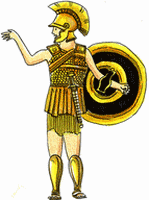Maps of the Antique
Mediterranean Sea
 Greece Greece
 Attic Attic
 Corinth Corinth
 Magna Graecia Magna Graecia
 Apulia Apulia
 Daunia Daunia
 Some dates Some dates
 Archaeological sites Archaeological sites
 Pottery and ceramics Pottery and ceramics
 Gnathia Gnathia
 Campania Campania

|
DAUNIA

|
Daunia is located mainly in the peninsula close to today's Foggia, on the Adriatic shore of Italy. In the Antiquity, it extended deeply towards the interior,up to the area of Molise.
This area was already occupied at the stone age. As commonly admitted, towards 1300 B.C. an Illyrian people, the Iapyges - to which, according to some sources, mycenians would have joined - settled down in Apulia, and later divided into three populations : the Daunians in the north, the Peucetians in the center, and the Messapians in the south. The tradition considers that the Ofanto river was the natural border between Daunia and Peucetia.
As far as Daunia is concerned, a doubt remains however.
|
According to some authors, the correct translation of the greek source would be that Iapyges settled "up to Daunia" , without specifying if Daunia was or not included in the Iapyges territory.
Daunos and Diomedes
According to the legend, when Diomedes, king of Argos, came back from the Trojan war, he found he had been enthroned by the son of Sthenelos, the lover of his unfaithful wife. Being forced to leave Greece, he reached the islands of Tremiti (which will become the "Diomedes' islands"), then landed on the shore and founded Argyrippa (or Argos Hippium, today Arpi). Encountering the native populations, he requests the assistance of king Daunos, legendary founder of Daunia, but later Daunos (or his son) killed him by accident during hunting.
According to another version (Diomedes is a recurrent character in the legends from the Adriatic coast!), Diomedes, on the contrary, would have assisted king Daunos, and married then his daughter Drione. He would then have founded the town of Castrum Drionis (Casteldrione, today San Severo) and would have built two temples there. As a recognition for his help against theMessapians, he would have then received a part of Apulia, the "fields of Diomedes").
Daunians and Greeks
We know that the Daunian people occupied the cape of Gargano, then extended its influence on the neighbourhood, while remaining a whole of small unified villages. Between the 5th and the 4th century B.C., these small villages enclose themselves with city walls and the main urban centres are connected by roads
The Daunians meet the greek people when, from the 8th to the 5th century B.C., the Greek launched their large colonization expansion around the western Mediterranean sea. In Sicily, for instance, the greeks met with people who had already partially assimilated some elements of the mycenian civilization, but who migrated later towards the inland during the "dark times" (1100 to 800 B.C.). On the contrary, in Apulia, the Greeks encountered organized people with their cities and their own structure. They could found there only one colony, Taranto.
This will not prevent the hellenic culture from penetrating deeply among the Iapyges, which will adopt the annual rotation of cultures and the fallow land. On the heights, breeding of sheep and agriculture replace the Mediterranean bushland.
Roman Daunia
When the Romans occupy the Italian peninsula during the 3rd century B.C., the daunian culture evolves radically. Road networks reinforce the links between the farming areas and the cities.
In the 2nd century A.D., the Via Traiana connects Benevento to Brindisi and pass through Canosa, bringing an alternative to the old Via Appia. Daunia stands thus no more away from the other countries.
Even today, most of the road network, in particular around Canosa and Canne (the most important center of this period, still very rich in archaeological treasures), is an inheritance from the roman layouts.
|
|

















